St. Augustine's Caves

The Grange, on the Westcliff of Ramsgate
.
These extensive caverns were supposed to have been used in both World Wars as civilian Air Raid shelters and apparently could hold many thousands of people. The system even included an underground ballroom!!
They are shown on a plan of the Ramsgate WW2 Air Raid tunnel system, marked as 'Existing Caves':

During the second world war a public entrance was dug into this tunnel system from the public recreation ground opposite, which has long since been sealed up. The outline of it can still be seen in the grass during the summer months. The only remaining access into this underground tunnel system is from beneath the Grange itself.
Access to the cliff entrances were sealed up in the late forties, during the cliff defences construction work which has now obscured most of them, although some blocked entrances to this system can still be seen along the cliff face today
 A rare photo of St. Augustines caves, c.1948, before the cliff defences were constructed
A rare photo of St. Augustines caves, c.1948, before the cliff defences were constructed
For many years, we have tried to find a way into this old system, and find the rumoured underground ballroom, until recently I came across some photos showing that in 1947 that whole section of cliff collapsed in on itself, destroying a large part of these underground caves! The ball-room, along with many of the other tunnels, were exposed clearly in these photos, as shown below.
It seems perhaps Pugin built one tunnel too many! I suspect that the area was weakened considerably by these unsupported caverns and catacombs, and then due to sustained bombing in WW2 and particularly harsh weather conditions finally caused the major collapse that you see here...
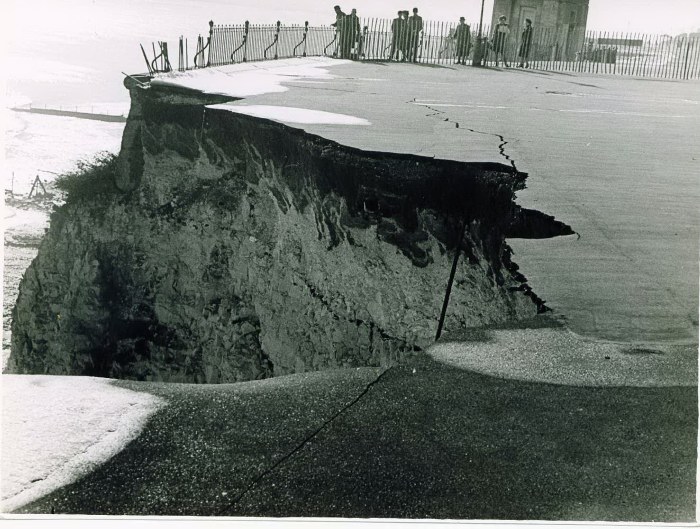
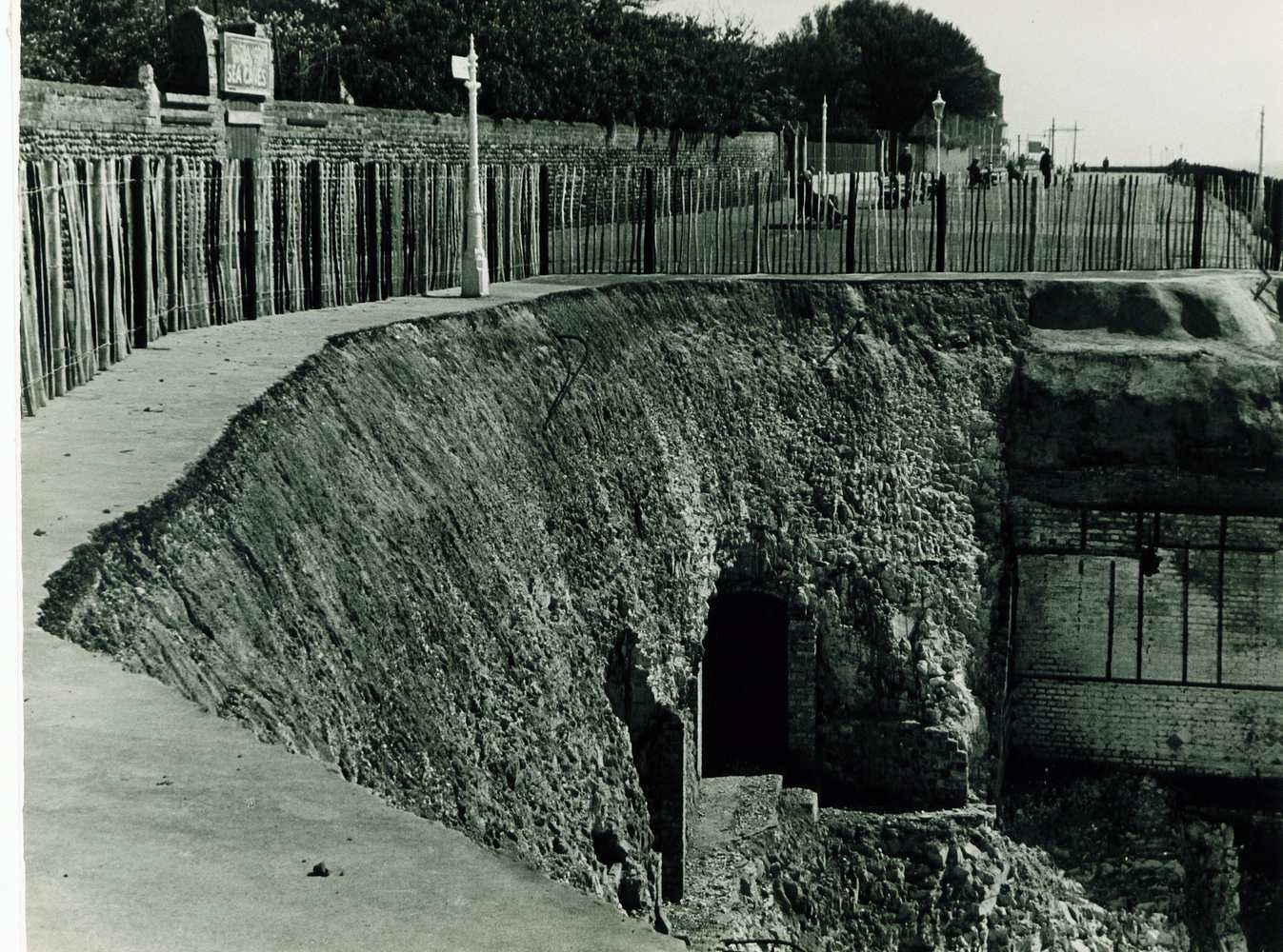 In this exposed cavern, you can clearly see the brick wall (below right) of what appears to be a large underground room. I suspect this was the ball-room, which likely had a balcony on the cliff face, overlooking the sea
In this exposed cavern, you can clearly see the brick wall (below right) of what appears to be a large underground room. I suspect this was the ball-room, which likely had a balcony on the cliff face, overlooking the sea
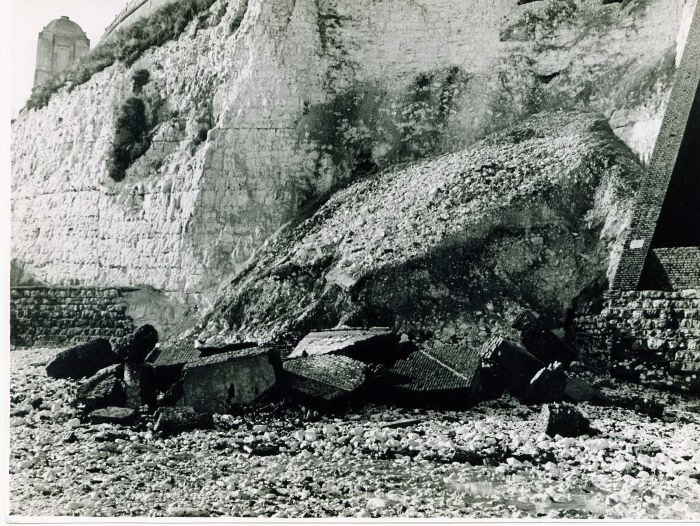 I hope nobody was standing underneath that lot when it fell!
I hope nobody was standing underneath that lot when it fell!
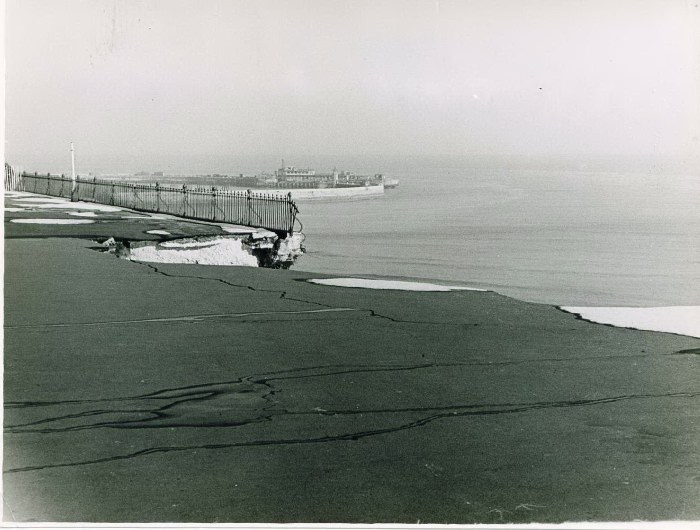
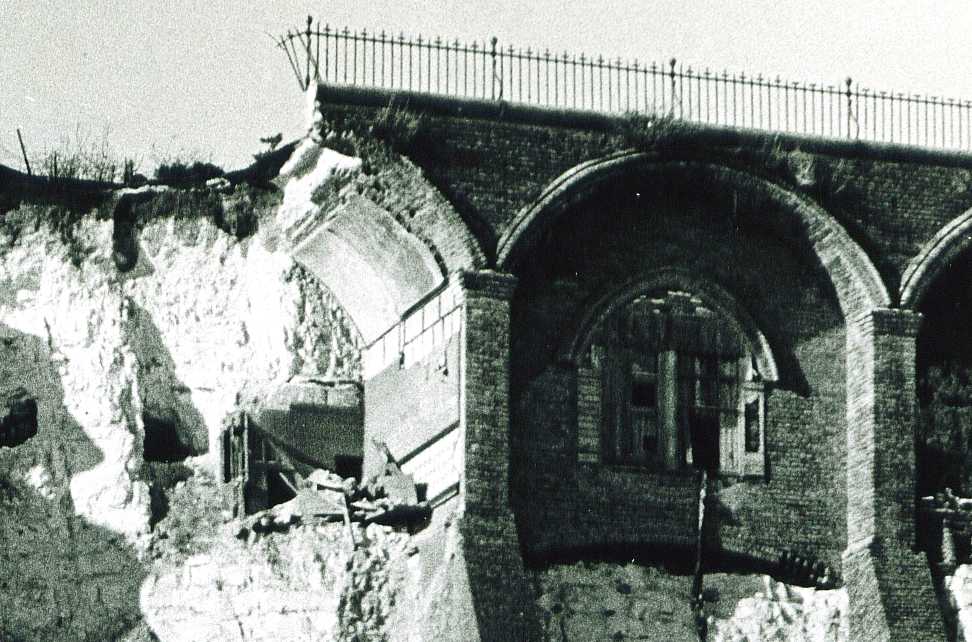 Here you can clearly see an underground room (still intact) to the right, which opened onto the cliff face. The room on the left has been destroyed by the collapse, but several tunnels can still be seen entering the cliff from the rear of (what was) a large room. These tunnels likely connected with the other caverns, and up to the Grange
Here you can clearly see an underground room (still intact) to the right, which opened onto the cliff face. The room on the left has been destroyed by the collapse, but several tunnels can still be seen entering the cliff from the rear of (what was) a large room. These tunnels likely connected with the other caverns, and up to the Grange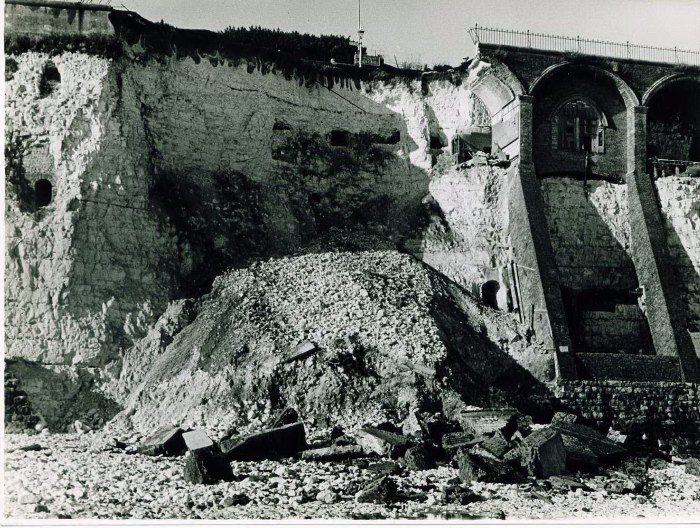 Another view of the collapse, showing the exposed caverns behind it
Another view of the collapse, showing the exposed caverns behind it
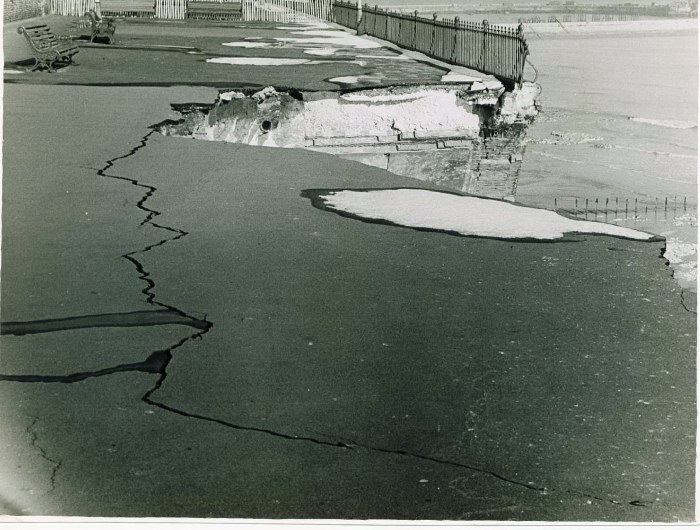 A large chunk has been taken out of the cliff during the collapse. The exposed brickwork beneath the surface shows just how close to the surface some of these underground rooms were. The large crack in the ground looks scary!
A large chunk has been taken out of the cliff during the collapse. The exposed brickwork beneath the surface shows just how close to the surface some of these underground rooms were. The large crack in the ground looks scary!
Many Thanks to Michael's Bookshop where these images have been borrowed from.
Since this collapse, significant reinforcement work has occurred to the Westcliff, with large concrete arches being constructed to strengthen them. These completely obscure what's left of these underground caves today, except for some blocked entrances still visible at ground level, and even a couple of open entrances tantalisingly out of reach, high up in the cliff.

 A close up of another blocked entrance
A close up of another blocked entrance
 One of the open entrances, higher up the cliff face. It was originally blocked by a brick wall about 6 feet inside the tunnel, which has been broken through. Would make for an interesting abseil!
One of the open entrances, higher up the cliff face. It was originally blocked by a brick wall about 6 feet inside the tunnel, which has been broken through. Would make for an interesting abseil!
Epilogue:
In 2003, the Kent Underground Research Group were invited to the Grange (during it's restoration) to investigate a tunnel that had recently been uncovered in the basement, beneath a large trapdoor. I was fortunate enough to be part of that team.
A long flight of narrow wooden steps lead down into a high, narrow chalk tunnel, with an arched ceiling, carved out of the chalk. The ceiling was supported by old wooden beams.
The tunnel twisted and turned quite a bit, and after about 200 metres, came to an end. There was a blockage straight ahead, likely caused by a roof fall, preventing us going any further. Also to our right was a brick wall. Due to the salty smell in the air, and the sound of seagulls beyond this wall, we suspected it lead out to the cliff face, and was one of the blocked exits. Sadly the collapse ahead of us prevented any further exploration of this fascinating man-made cave system. This access tunnel was likely built by Pugin as the original entrance into this cave system that he had constructed.

Diagram of the cliff face as it appears now, with two of the higher up entrances shown, which are still visible today, and thought to be accessible
-
The Pugin Tunnel
The following personal account was written by the daughter of a groundsman who worked at the Grange many years ago, and is published in the Ramsgate Millenium Book, relating to the tunnel beneath The Grange:
"In the 1930's, Paddy O'Brien used to dress as a pirate and take people into the tunnel which ran from The Grange to the foreshore below. There was a gate in the wall. People would go through this, and just inside the garden was an entrance to the tunnel.
They went down a few steps and were in the tunnel. Mr. O'Brien would take them up towards the house and down to the bottom. There was an entrance inside The Grange which was not used by the public but which I've used - you pulled back a tapestry which kept out the draught by the kitchen in The Grange.
It was only a tunnel. There were no "rooms" down there. There were two or three 'run-offs' - short tunnels - which you could stand in. There was no light in there. You had to take a lantern.
The tunnel opened onto the foreshore, near the lift entrance. Protecting the opening was an iron grating. Father used to go down there regularly. He said that Pugin used to tie a dinghy to the gate. Pugin used it to row out to his boat in the harbour. Presumably Mr. O'Brien was at the top entrance all day during the summer, taking visitors down for a few pence each. He worked for the Abbey which owned The Grange and was odd job man for them.
In those days the monks were not allowed out of the Abbey except on business or religious duties. You wouldn't even see them coming out of the door to cross the road to the church - they would use the tunnel. I don't know how true this is, but I was told that the tunnel was constructed to save the monks from being run over by the trams coming round the corner from Grange Road.
The tunnel was exposed after the cliff had collapsed. During the War, the big guns were located there. When they fired them, the pavement cracked. No repairs were done. Moisture and frost got in, and after the War the cliff collapsed. They filled in the gap with concrete and sealed off the entrance to the tunnel."
So it seems there is only firm evidence of a single tunnel, running beneath the Grange to the foreshore beneath the cliffs, with a few short off-shoots. The elusive 'cave network' , with its many cliff face entrances (as shown in the 1940's photograph above) remains a mystery!
Labels: caverns, caves, st. augustine, westcliff
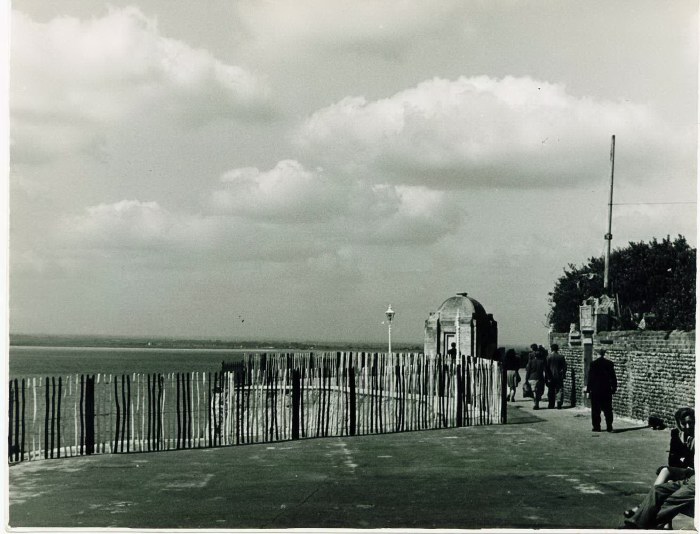

20 Comments:
Once again you have shed light on a fascinating part of Ramsgate's history and saved me the bother of another attempt to get into these tunnels as it appears not a lot is left of them. Isn't it ironic though that all these years on the council seem perfectly willing to allow the same thing to happen (ie a cliff to collapse)on the eastcliff where there is another large sytem of caves (crudely bricked up entrance to which is in old pleasurama site next to the lift shaft)which are most certainly in danger of suffering the same fate as Pugin's? Excellent stuff Vince, keep it up!!!
Another speleological triumph, Vince old chap!
On the subject of ballrooms, have you ever considered burrowing under the Granville? The fellow who came to read my meter yesterday had been chatting to the janitor there, and was told there was, or had been, an underground ballroom on that site too, as well as a tunnel that used to take patrons down to Ramsgate Sands station for the 'Granville Express'.
Maybe Pugin Jr got the idea for the subterranean ballroom from his dad?
Vin - Let me know if you want some pictures of inside the caves and a plan......
Thanks for your comments all.
It would be great to get into that cave system near the Granville, as I expect there may not be much left of that either once the cliff reinforcement work starts there (but by the look of the counter on your excellent site Mr. Eastcliff, I doubt that will be any time soon!)
Doverpast: Would love some pics and a plan if you have them! I've found it very difficult to get any images from inside that system, or a plan for that matter!
I loved reading through this. I've lived in Ramsgate all my life and i'm very intrested in any more information you may have. I'm epecially lookig into the history of Newington. Many thanks, Claire
clair i was working in newington and spoke to a elderly lady who said she was the first resident of newington she moved in to no 1 ringold ave the first house built in 1947 she still lives there the pub the flowing bowl was the last to be constucted of that era hope this is of some help in your research.
People should read this.
Yes there was a ballroom in both places as my nan went to all the balls that were there .Also I remember getting the train down from near Dumpton Gap to the beach.My nan also told me about the RAILWAY.Rember there was also a lift that went down from the Granville to opposite where the Marina swimming pool was.I have been in it when little.
KF
in your sketch of the two cliff entrances you have said they were both pretty much inline with the abbey. infact the second entrance is a long way down the cliff closer to the smugglers church. Great report guys well done, this is one place that no one has got the chance to see which is a real shame.
The monks of St Augustine's Abbey used to own the Grange, and ran these caves as a tourist attraction and revenue earner before WWII. There are still enlarged copy photos of postcards of the system that were sold, which are presently in the cellar of the monastery library. They seem to be unique.
Further to the above. The tunnel explored in 2003 cannot be the same one that I knew in the Grange, which opened under the main staircase just to the left when entering by the front door. This one went down a flight of stairs, then straight down a gradient to a brick blocking wall. There was a short blind tunnel heading east at the foot of the stairs.
There is a tunnel under the new, seaward section of the graveyard,which used to be part of the garden. A grave being dug c1988 broke into it, but no exploration was done.
There is a possible WWI air-raid shelter under the monastery's kitchen garden, being a chalk-cut staircase, a short wide passage and a much narrower return passage ending in fill. It has been sealed off, but I was the first down there when it was discovered.
In response to their being shown the monastery's photos of the cave system, Landmark Trust opened up the cave passage under the Grange for the staff and myself to explore, on Sep 12th. It's hoped that there will be a display concerning the cave system set up at the Grange. Just to say here that there is only one cave passage under the Grange (the description given above was misleading), and that the ballroom story probably derives from an old lady of the Pugin family misremembering the Westcliff Concert Hall (later the motor museum).
More to follow.
Hi Basil. Many thanks for your comments - its always good to hear first hand from an "insider", as it were!
I have since done a bit more research, and added the section "The Pugin Tunnel" to the above post, which concurs with your account. I hope you find it of interest!
The cliff revetment before the collapse appears on an aerial photo in the "Ramsgate Millennium Book", 12:3. If you compare this with the 1948 photo, you will see that there are two smaller entrances into the cliff under the graveyard, nearer the top. These are nowadays obscured by vegetation.
The Landmark Trust investigation was a great success, and the results are goint to their historian for a write-up. Briefly, the passage from the Grange led to four brick-arched chambers below the promenade, with a rock-cut passage connecting them. There was at least one rock-cut chamber below these. A stairwell cut into the cliff runs down to the former beach from the Grange passage just where it has its modern blocking wall, but has been backfilled. There was another, lost entrance to the chambers from the SE corner of the Grange garden, and another lost one from Government Acre. The cemetery passages remain a mystery.
Basil describes very well what I remember of the entrance to the caves under the main staircase at the Grange. Some of the boys went exploring one night and were punished for their adventure. I think that I'm right in saying that the entrance under the stairs was through a door that was part of the staircase Gothic panellig and this door and panelling was later removed just leaving a trapdoor or even concrete? to seal the entrance. I remember it was an eyesore after the original but the monks never worried about their heritage!Vandals every one of them!
I have some photos of what i believe to be pugins tunnel. It was accessed after getting permission from land management in charge of where the entrance is.
photos can be seen here....
http://www.youtube.com/watch?v=ocDw0zxYfqM
I too was lucky enough to be able to explore the Grange tunnel during the refurbishment. The comments above are accurate. We also investigated the opening in the cliff, abseiling down a rope anchored to the back of my Land Rover! This was not the fabled ballroom, but a passage parallel to the cliff face was found.
David
My mates and I explored the ledge beneath the Grange, in approx. 1955,when I was 10 years old.
I now have a web page, about that, at http://www.ky-filters.com/wc.htm
In an article, that I once read, it said that the only way down to the Harbor was down Jacob's ladder.
I remember the cave openings that looked like arched doorways, when I was there, as a kid.
I bet that is how Pugin got down to the Harbour, in a hurry, to get his crew and salvage boat going.
The place where we gained access to that ledge was only about 50 yards from Jacobs Ladder, the sailors Church, and the Smack boys home.
John Browne
Davis, CA
USA
I did some exploring of the West cliff undercliff area in approx. 1954,at the age of 9n yrs. You can read about it at
http://www.ky-filters.com/wc.htm
John Browne,
Davis, California
I came across this whilst googling for collapsed sea caves. A fascinating read!
Post a Comment
<< Home